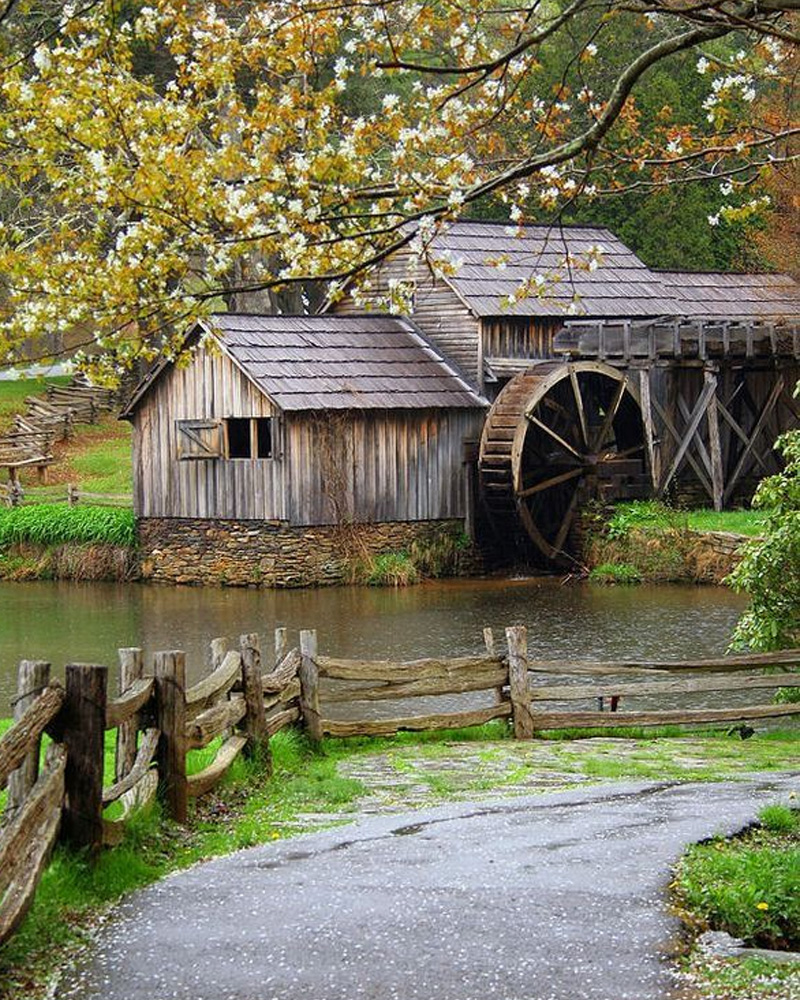During the Great Depression, a plan to build a parkway through the southern Appalachians of Virginia and North Carolina was put into motion. This rural parkway, named Blue Ridge Parkway, is the first one to be built in America and is the longest, stretching some 469 miles. It's also a connecting route between two national parks: the Shenandoah National Park and the Great Smoky Mountains National Park.
As this route winds along, at times leaving the traveler in awe at the breathtaking views of mountains and pastures, it passes by one of the most iconic places in Virginia: the Mabry Mill. This historical structure is toured yearly by thousands of visitors who come from all parts of the world. And yet, when the mill first started operations more than a century ago, the majority of people visiting the mill came from locations within an 8 mile radius. The vast difference between today and the way it was back then is mind boggling, as I am sure it would have been for the founders of the mill had they been able to get a glimpse of it.
The Mabry Mill was founded by Ed and Lizzie Mabry. It had been their dream to have their own gristmill, so around 1905, with the help of a neighbor, some hand tools, and a lot of hard work, their dream began to take shape. In 1908 the mill began operations and Ed, being the enterprising man he was, had Lizzie take over the milling (it was reputed she was a better miller than he was anyways), while he went onto his next project: building a sawmill. By 1910 the sawmill, which was located to the left of the gristmill, was completed and Ed began building a woodworking shop. This shop was located on the right side of the gristmill. A blacksmith and wheelwright shop was also part of the complex, making the mill a full service business where you could get wood sawed, a wheel on the wagon fixed, while you were waiting for your corn to be ground into meal.
According to my research, the grinding process at Mabry Mill was slower then most mills. The more water volume there was to power a mill, the faster the corn would be ground. But the stream generating the power for the Mabry Mill was fairly small, resulting in a lengthier grinding time. However, there was a benefit to it; that slower grinding process prevented the corn from getting scorched or burned and leaving the corn meal with a bitter taste. Despite the patrons having to wait a little longer for their corn to be ground, the word soon got out that Mabry Mill had some of the best tasting corn meal around!
After years of extensive labor building up their business, the Mabry's had one more structure to construct. In between 1918 and 1920 they built for themselves a white, two story farmhouse. Like much of their business, they built it with the labor of their hands and with the skill they had acquired. But Ed became ill in the 1930's and, after passing away in 1936, Lizzie was fearful of staying in the farmhouse alone and it was dismantled. In 1938 the National Park Service acquired the mill property for the purpose of building the Blue Ridge Parkway through a portion of that land. The plans the Park Service had for the mill at that time was to "make a scenery" out of it. Lizzie was reportedly thrilled about it, as the mill had fallen into disrepair and was becoming inoperable otherwise.
Not much is known about Lizzie Mabry after that. It is said she relocated to live with her sister. But what a legacy to leave behind! Today there are thousands of visitors who travel that scenic parkway to catch a glimpse of the labor, the skill - the dreams - one couple had over a century ago.

